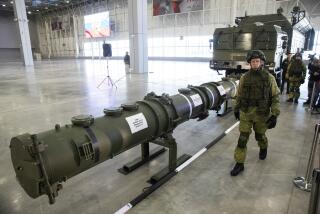State, Defense Depts. Differ on Soviet Plant Inspections
WASHINGTON — Sen. Pete Wilson (R-Calif.) on Tuesday told President Reagan that there is a disagreement between the State and Defense departments over the Soviet Union’s right to inspect General Dynamics facilities at San Diego under the new intermediate-range nuclear missile treaty with the Soviet Union.
In a letter to the President, the senator declared, “It is imperative that there be an early resolution” of the departments’ conflicting interpretations and a notification to the Soviet government.
At issue is the treaty’s provision for inspection of a General Dynamics facility where the company manufactures transporter-erector-launchers for ground-launched cruise missiles, which are to be banned under the treaty signed by President Reagan and Soviet leader Mikhail S. Gorbachev on Dec. 8.
The equipment is manufactured in Building No. 3 at the General Dynamics Convair Plant 19, near San Diego’s Lindbergh Field.
Two Other Buildings
But Wilson said senior Defense Department officials “intimately involved in the negotiations” believe that the agreement also allows the Soviets to inspect Building No. 1 and Building No. 2, where the firm hopes to build rail-mounted launchers for the new mobile MX intercontinental missile. It is now competing for an MX contract to be awarded by the Air Force.
The MX system is not covered by the intermediate-range missile treaty.
If Buildings No. 1 and 2 are available for Soviet inspection, Wilson said, “then obviously the Air Force cannot award the work to General Dynamics at this facility.”
Since Building No. 3 is the only housing covered by the new treaty, Wilson said, logic dictates that it should be the only one subject to inspection. That was the position taken by State Department officials, who briefed Wilson on the agreement.
But Wilson told the President that he had doubled-checked his understanding with Defense Department experts and that they reiterated their belief that the agreement, as written, allows the inspection of all three buildings.
“Because of the great importance that we both attach to the rail-mobile MX as an essential element of U.S. deterrence against nuclear attack by the Soviet Union, it is imperative that there be early resolution of the difference in understanding as between State and Defense,” he said in his letter. “And, obviously, it is necessary that the Soviets be apprised of the U.S. understanding so that they will not be under any misapprehension as to their inspection rights.”
Under the treaty, Soviet inspection teams will be stationed only at a single weapons plant in Utah, but inspectors will have a right to visit the General Dynamics facility where the transporter-erector-launchers are built as well. The inspections over the next 12 years are the treaty’s insurance against a covert buildup of the banned cruise missiles.
Neither State Department nor Defense Department officials would comment on the matter Tuesday. A spokesman for General Dynamics said only that “if there are uncertainties, we hope and expect they will be resolved to the satisfaction of all concerned.”
As the first session of the 100th Congress adjourned Tuesday, senators agreed to begin hearings on ratification of the treaty on Jan. 25. Secretary of State George P. Shultz is to be the leadoff witness.
Sen. Claiborne Pell (D-R.I.), chairman of the Senate Foreign Relations Committee, had initially hoped to begin the hearings on Jan. 29 and complete them by the end of February.
Indications thus far are that the pact will easily get the two-thirds majority required for ratification, especially since the announcement by Senate Minority Leader Bob Dole (R-Kan.) that he will support it.
State Department sources said the treaty and supporting documents will be ready for submission to the Senate shortly after the first of the year.
More to Read
Sign up for Essential California
The most important California stories and recommendations in your inbox every morning.
You may occasionally receive promotional content from the Los Angeles Times.










